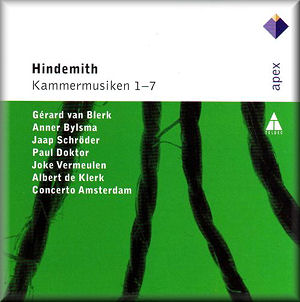 |
 |
|


alternatively
CD: AmazonUK
AmazonUS
|
Paul HINDEMITH (1895-1963)
Kammermusik No. 1 for 12 solo instruments Op. 24 No. 1 (1921) [14:53]
Kammermusik No. 2 for piano and 12 solo instruments Op. 63 No. 1
(1924-5) [19:43]
Kammermusik No. 3, for cello and 10 solo instruments Op. 36 No.
2 (1924-5) [17:39]
Kammermusik No. 4, for violin and large chamber orchestra Op. 36
No. 3 (1924-5) [22:00]
Kammermusik No. 5, for viola and large chamber orchestra Op. 36
No. 4 (1927) [19:17]
Kammermusik No. 6, for viola d’amore and chamber orchestra Op. 46
No. 1 (1927) [17:35]
Kammermusik No. 7, for organ Op. 46 No. 2 (1927) [16:11]
 Gérard van Blerk (piano)
Gérard van Blerk (piano)
Anner Bylsma (cello)
Jaap Schröder (violin)
Paul Doktor (viola)
Joke Vermeulen (viola d’amore)
Albert de Klerk (organ)
Concerto Amsterdam
rec. September/December 1967, January 1968, Felix Meritis, Amsterdam
and Concertgebouw Haarlem (Op.46 No.2)
 WARNER CLASSICS APEX 2564 67318-9 [74:40 + 54:02]
WARNER CLASSICS APEX 2564 67318-9 [74:40 + 54:02] 
|
|
|
I’ve known and loved the Concertgebouw recording of this cycle
of remarkable works with Riccardo Chailly at the helm (see review)
since it was first released, and as a complete cycle this recording
is pretty hard to beat. Despite the vintage of the Concerto
Amsterdam recording, which I had previously only known by reputation,
this Warner re-release has me agape.
We’re now almost spoilt for budget re-release choice in this
repertoire it would seem. EMI has its cycle with Claudio Abbado
which includes a very fine recording of Der Schwanendreher.
The Chailly Decca recording likewise is available in re-release
form with the slightly less interesting Kleine Kammermusik
wind quintet as a filler, but still tipping the balance
in terms of recording quality, soloists and sheer verve. This
Concerto Amsterdam recording counts as ‘historic’ these days,
but with one or two minor caveats this is a remarkably fine
document which still sounds pretty fresh, and most certainly
preserves performances of the highest order.
Kammermusik No.1 is a big favourite in a top performance,
epitomising Hindemith’s spiky wit from the opening ostinati
to the final whoop from a slide whistle. The quality of the
playing is second to none, and one or two moments of dated sounding
vibrato aside sounding really up to the minute. The piano solo
of Kammermusik No.2 does sound a bit boxy which is a
little odd, as the rest of the instruments sound fine. The Felix
Meritis acoustic is quite a big one, but suits this punchy wind
writing well. The balance for Anner Bylsma’s big-boned cello
is good too, mixing well with the other instruments rather than
dominating the picture. The energy in the playing sparks and
flies in the Lebhaft und lustig second movement, and
the funereal tread of the following movement is richly expressive,
despite some edgy intonation here and there. Kammermusik
No.4 is for violin solo and large chamber ensemble and is
on a larger scale than most of the other works in the series.
The winds are very evocative of the period, with a hint of Kurt
Weill in the sound, though Hindemith maintains his neo-classical
objectivity, with cool expression in the slow movements, angular
and rhythmic directness in the swifter movements. The final
movement is a quiet but testing So schnell wie möglich
non-stop line for the violin solo with little proto-Shostakovich
interjections from the band. Early music pioneer Jaap Schröder
is perhaps not the strongest of soloists for this piece, but
he does a decent enough job, and the recording balance is once
again very realistic.
Disc two brings us Kammermusik No.5 for Hindemith’s own
instrument, the viola, plus another large chamber orchestra.
Virtuoso elements for the solo are to the fore, and the emotionally
laden Langsam movement is one of the most heartfelt of
the entire set. Paul Doktor’s playing is expressive, but his
tone is ‘troubled’ by a vibrato which doesn’t really let up
even where the music would seem to demand a more open sound.
The musicians clearly relish the final military march, which
closes the work in a rollicking satire. The almost defunct viola
d’amore is another instrument favoured by Hindemith, and the
Kammermusik No.6 was also written for his own use as
a performer. This piece has a generally sunny aspect, and Joke
Vermeulen’s light and refined solo sound suits this very well
indeed. Her cadenzas in the Variationen are fine indeed.
The final Kammermusik No.7 takes us to a different location
with an even bigger acoustic. I can’t see the organ in the centre
of that great concert hall in Haarlem without superimposing
a striking and frightening image: that of a huge Swastika draped
over it, photographed during an NSB gathering at the hall in
May 1944. A mere 24 years later and renowned Dutch organist
Albert de Klerk brings the voice of the instrument to vivid
life in this fine recording, with the solo balanced well with
a well intonated chamber orchestra – not an easy trick to bring
off. I like Hindemith’s writing for organ, and this is a cracking
concerto with which to end the series.
If I have one criticism of this release it is the entire lack
of any booklet notes or documentation about the recording or
musicians. I know this is a budget release, but I can hardly
imagine it would have cost much to re-print whatever texts had
gone with earlier Teldec editions. Other labels manage to keep
up standards in this regard, so there really is no excuse in
this case. That said, if you see a copy of this, buy it without
a second thought, even if you already have Chailly’s or Abbado’s
recordings. These performances have a character which brings
an entire mood and period to life – one which the all too frequently
homogenised and squeaky-clean perfection of today can rarely
rival, and one which you feel brings us closer to the actual
composer than many an alternative.
Dominy Clements
|
|

